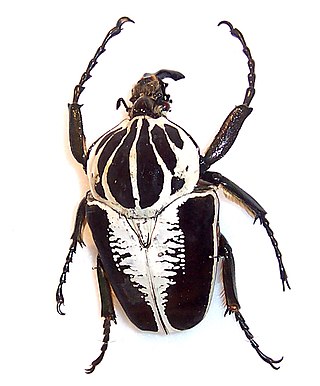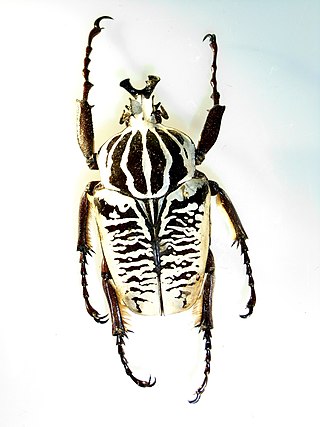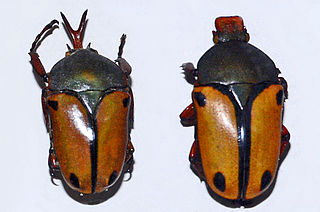
Silphidae is a family of beetles that are known commonly as large carrion beetles, carrion beetles or burying beetles. There are two subfamilies: Silphinae and Nicrophorinae. Nicrophorines are sometimes known as sexton beetles. The number of species is relatively small at around two hundred. They are more diverse in the temperate region although a few tropical endemics are known. Both subfamilies feed on decaying organic matter such as dead animals. The subfamilies differ in which uses parental care and which types of carcasses they prefer. Silphidae are considered to be of importance to forensic entomologists because when they are found on a decaying body they are used to help estimate a post-mortem interval.

Histeridae is a family of beetles commonly known as clown beetles or hister beetles. This very diverse group of beetles contains 3,900 species found worldwide. They can be easily identified by their shortened elytra that leaves two of the seven tergites exposed, and their geniculate (elbowed) antennae with clubbed ends. These predatory feeders are most active at night and will fake death if they feel threatened. This family of beetles will occupy almost any kind of niche throughout the world. Hister beetles have proved useful during forensic investigations to help in time of death estimation. Also, certain species are used in the control of livestock pests that infest dung and to control houseflies. Because they are predacious and will even eat other hister beetles, they must be isolated when collected.

Dermestidae are a family of Coleoptera that are commonly referred to as skin beetles. Other common names include larder beetle, hide or leather beetles, carpet beetles, and khapra beetles. There are over 1,800 species described.

Dynastinae or rhinoceros beetles are a subfamily of the scarab beetle family (Scarabaeidae). Other common names – some for particular groups of rhinoceros beetles – include Hercules beetles, unicorn beetles or horn beetles. Over 1500 species and 225 genera of rhinoceros beetles are known.

Dynastes tityus, the eastern Hercules beetle, is a species of rhinoceros beetle native to the Eastern United States. The adult's elytra are green, gray or tan, with black markings, and the whole animal, including the male's horns, may reach 60 mm (2.4 in) in length. The larvae feed on decaying wood from various trees.

Allomyrina dichotoma, also known as Japanese rhinoceros beetle, Japanese horned beetle, or kabutomushi, is a species of rhinoceros beetle.

The Goliath beetles are any of the five species in the genus Goliathus. Goliath beetles are among the largest insects on Earth, if measured in terms of size, bulk and weight. They are members of subfamily Cetoniinae, within the family Scarabaeidae. Goliath beetles can be found in many of Africa's tropical forests, where they feed primarily on tree sap and fruit. Little appears to be known of the larval cycle in the wild, but in captivity, Goliathus beetles have been successfully reared from egg to adult using protein-rich foods such as commercial cat and dog food. Goliath beetles measure from 60–110 millimetres (2.4–4.3 in) for males and 50–80 millimetres (2.0–3.1 in) for females, as adults, and can reach weights of up to 80–100 grams (2.8–3.5 oz) in the larval stage, though the adults are only about half this weight. The females range from a dark chestnut brown to silky white, but the males are normally brown/white/black or black/white.

Strategus aloeus, the ox beetle, is a species of rhinoceros beetle native to the Americas.

Goliathus albosignatus is a species of beetle of the family Scarabaeidae, described by Boheman in 1857. It is one of several species of Goliath beetles that inhabit Africa, but it is the only one exclusively found in subtropical sections of the continent.

Goliathus orientalis is a species of beetles belonging to the family Scarabaeidae.

Melolonthinae is a subfamily of the scarab beetles. It is a very diverse group; distributed over most of the world, it contains over 11,000 species in over 750 genera. Some authors include the scarab subfamilies Euchirinae and Pachypodinae as tribes in the Melolonthinae.

The foreign grain beetle is a species of beetle in the family Silvanidae. It is related to the sawtoothed grain beetle.

Nicrophorus orbicollis is a nearctic burying beetle first described by Thomas Say in 1825. It is a member of the genus Nicrophorus or sexton beetles, comprising the most common beetles in the family Silphidae. This species is a decomposer feeding on carcasses of small dead animals. N. orbicollis can be used for scientific research both medically and forensically.

Eudicella gralli, sometimes called the flamboyant flower beetle or striped love beetle, is a brightly coloured member of the scarab beetle family, in the subfamily known as flower beetles. Their shells seem to have a prismatic quality, refracting the ambient light to give the green of their carapace a rainbow tint. This species of flower beetle lives in the rainforests of Africa, where it feeds on the nectar and pollen of flowers, but is popular in the exotic pet trade. The larvae of the flower beetle live in decaying wood, feeding on dead wood and leaf litter. Adults reach lengths of 25–40 millimetres (0.98–1.57 in). As in other species of this genus, the males have a "Y"-shaped horn, used to fight over females. The females have a shovel-like tusk, used for burrowing in wood. During their gestation period they will dig into the wood and lay eggs.

Eudicella euthalia is a tropical, east African species of flower beetle in the genus Eudicella, belonging to the subfamily Cetoniidae.

The Moellenkampi beetle, is one of four large species of rhinoceros beetles from Southeast Asia belonging to the genus Chalcosoma. The Moellenkampi beetles belong to the beetle family Scarabaeidae along with other rhinoceros beetles. They are characterized by having two large, forward-projecting horns on the pronotum or thorax, and another large, forward and upward-projecting horn on the head. They also have a distinct metallic lustre, which is the reason behind their genus name, which derives from Greek, chalko-, and is the combining form of chalkós, meaning copper.

Mecynorhina passerinii, the Orange-Spotted Fruit Chafer, is a species of beetles belonging to the family Scarabaeidae, subfamily Cetoniinae.

Eudicella smithii is a species of African scarab beetle in the subfamily Cetoniinae, the flower beetles.

Euthyrhynchus floridanus, the Florida predatory stink bug, is a species of carnivorous shield bug in the family Pentatomidae, the only species in the genus Euthyrhynchus. It is native to the hottest parts of the southeastern United States and is considered beneficial because it feeds on many species of pest insects. They also feed on things such as grasshoppers and other small insects. This species also hunts in a pack, with up to twelve.
Eudicella frontalis is a beetle which belongs to the group of flower chafers in the superfamily Scarabaeoidea.



















